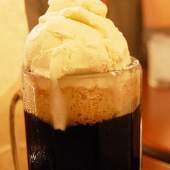Ice Cream Trucks

There are certain sounds that instantly conjure up a hot summer day in America – swimmers splashing in an outdoor pool, cheers at a baseball game, fireworks exploding in the sky, a racket hitting a tennis ball. But perhaps more than any other – especially for children – is the jangling melody emanating from an approaching ice cream truck. If you can catch up to it and have a little money to hand over to the ice cream man, you can enjoy a cold, decadent sweet treat that will help you beat the heat.
How long has the ice cream truck been synonymous with summer? When did it originate and how, and who invented it? How did this vehicle and its offerings evolve over the years? As National Ice Cream Month commences, let’s find out!
Ice cream in some form or other has been in existence for centuries, of course, ever since some genius got the idea to combine ice with sweeteners, and later milk or cream. In America, thanks to what we know about our Founding Fathers’ culinary proclivities and what some of their contemporaries have written, ice cream has clearly been a favorite since at least Colonial times.
Before modern refrigeration technology arrived on the scene, people were accustomed to having bulk ice delivered to homes via horse-drawn wagon (the iceman cometh?), to be installed in the family icebox where they kept their perishable food – they had to consume it fast before the ice melted. From there, it was a short jump to the ice-filled pushcart allowing vendors to sell cold foods, chiefly ice cream, to passersby on city streets. The original serving method left a lot to be desired – customers were given a small dish of ice cream (a “penny lick”) with no spoon – after the ice cream was eaten, the dish would be hastily wiped down for the next patron. (Ewww.) In addition to the decidedly unhygienic nature of this system, prior to the 1890s there was an additional element of risk involved, given that pasteurization didn’t yet exist, meaning that insufficiently refrigerated ice cream and other dairy products were laden with bacteria - it was not uncommon for people to sicken and die after consuming them. That hurdle cleared, vendors later sold ice cream sandwiches and ice cream cones, which were a much better idea all around.
In the early 1920s in Youngstown, Ohio, an ice cream parlor proprietor named Harry Burt created the Good Humor brand. Burt, the original “Good Humor Man,” was already hawking his wares on the streets from a portable icebox on the seat of his motorcar. One day, he came up with the idea of dipping a block of vanilla ice cream in melted chocolate, and then, to eliminate the need for a bowl and utensil, he mounted it on a stick. Children flocked to buy these new “suckers,” which cost a nickel and were neat and easy to eat on the go. Soon after, Burt devised the idea of a dedicated Good Humor refrigerated truck to bring his invention to neighborhood children. One truck became a fleet and then an empire as Burt’s idea took off, and while the Depression posed big challenges for the owners of brick-and-mortar ice cream emporiums, the lack of overhead and highly affordable price of ice cream truck menu items kept them in business as others went under. If you couldn’t come up with the price of an ice cream bar, there were also the cheaper twin popsicles, meant to be split in half and shared.
A competitor, Mister Softee, came along in Philadelphia in the mid-1950s, and was notable for another innovation from the two brothers who founded it: their trucks boasted the first mobile soft-serve ice cream machine.
Good Humor trucks were phased out in the 1970s, but you can still find their products in your grocery’s freezer case. (One of the early Good Humor vehicles is on display at the Smithsonian, if you want to see one.) Mister Softee trucks are still crisscrossing city streets today (mostly on the east coast and southern U.S.), where you can track them via mobile app. Most ice cream trucks these days are available by reservation only for your backyard event or block party, but there are still a few independent operators out there, and you never know when you’ll hear that familiar tinny rendition of “Turkey in the Straw” or “Pop Goes the Weasel” as one of them comes up your street.
Hurry – and don’t forget your loose change for that Dreamsicle, Crunch Bar, Push-Up, Oreo Sandwich, Strawberry Cheesecake Bar, Choco Taco, or whatever your favorite might be. Happy summer!





